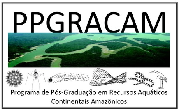PPGRACAM
PROGRAMA DE PÓS-GRADUAÇÃO EM RECURSOS AQUÁTICOS CONTINENTAIS AMAZÔNICOS
INSTITUTO DE CIÊNCIAS E TECNOLOGIA DAS ÁGUAS
Phone: Not available
E-mail: Not available
http://posgraduacao.ufopa.edu.br/ppgracam
Banca de DEFESA: TATIANE DA SILVA SANTOS
Uma banca de DEFESA de MESTRADO foi cadastrada pelo programa.DISCENTE : TATIANE DA SILVA SANTOS
DATA : 27/02/2019
HORA: 09:00
LOCAL: sala 3- ICTA
TÍTULO:
Gill mucous cells as environmental biomarkers of Hemigrammus levis DURBIN, 1908 at Juá Lake, Santarém, PA, Brazil
PALAVRAS-CHAVES:
anthropization, biomonitoring, gillsPÁGINAS: 67
GRANDE ÁREA: Ciências Biológicas
ÁREA: Ecologia
SUBÁREA: Ecologia Aplicada
RESUMO:
Water pollution is one of the major environmental problems of today and the aquatic biota is
one of the most affected by urban development. Fish are extremely sensitive animals, as they
can be contaminated by direct absorption of substances from the environment by the gills or
food ingested. The main objective of this research was to evaluate the density of mucous cells
of Hemigrammus levis collected in Juá Lake, Santarém, Pará, Brazil, as environmental
biomarkers, in addition to correlating cell density with lake water variables. The sampling
points (1 and 2) were defined based on geographic difference and based on previous
environmental impact information and also used for water collection. Point 1 is located in the
vicinity of anthropized area and point 2 is near the most preserved area. Flona (Tapajós
National Forest) was also used as the control environment. Samples were collected for 12
months, from April 2017 to March 2018. Fish (n = 130, 3.43 ± 4.2 cm standard length) were
placed in plastic bags with constant aeration before biometry and anesthetized in solution
eugenol (100 mg / L) to be submitted to the dissection and histological procedure of the gills,
in addition to labeling the cells. The sections were stained using Alcian Blue pH-2.5 solution,
Periodic Acid and Shiff Reactive. The gill mucosa cells were identified and quantified with
the aid of a microscope coupled with an image capture system and interactive measurement
program, thus obtaining cell density in mm². The water variables evaluated were pH,
temperature, dissolved oxygen, electrical conductivity, sodium, potassium, chloride,
ammonia, hardness and alkalinity, submitted to principal components analysis and Pearson
correlation. The mucosal cell density was analyzed from the Kruskal-Wallis and Mann-
Whitney Test. The analysis of water variables showed the stratification of the environment,
but the conductivity presented a higher concentration in point 1 over a year. Flona's
characteristics approached point 2, with a higher concentration of dissolved oxygen and lower
electrical conductivity, suggesting a preserved environment. In the species analyzed, it was
observed that the density of acidic and neutral mucous cells was modulated by the changes
that occurred in the physico-chemical variables of the water in the period of low water and
high water. The data suggest that pH and ammonia are the most important variables for this
effect. The species responded interestingly to the alterations in the medium, showing a
significant difference when the density of acidic and neutral mucosal cells were related in the
low water period, mainly in point 2, suggesting a stimulus in the production of mucous cells
and that this indicates to be caused by the increase of ammonia. Therefore, it is suggested that
Hemigrammus levis may be a potential species to be visualized as an environmental quality
bioindicator of Lake Juá, since it showed modulation of mucous cells in the face of
environmental changes.
MEMBROS DA BANCA:
Interno - 710.354.782-34 - ANDREA PONTES VIANA - UFPA
Presidente - 1544196 - DIEGO MAIA ZACARDI
Externo ao Programa - 1636625 - MICHELLE MIDORI SENA FUGIMURA
Interno - 1776668 - YNGLEA GEORGINA DE FREITAS GOCH
Notícia cadastrada em: 25/02/2019 16:10
SIGAA | Centro de Tecnologia da Informação e Comunicação - (00) 0000-0000 | Copyright © 2006-2024 - UFRN - srvapp2.ufopa.edu.br.srv2sigaa




